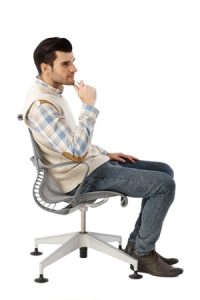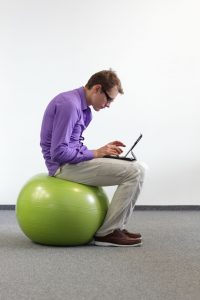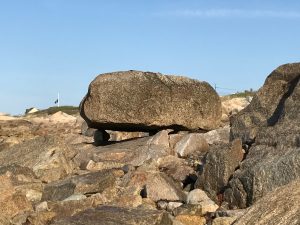This post may contain affiliate links.
If you are like me you sit a lot! You sit at the computer, you sit in your car, you sit to eat meals or watch TV.
We sit too much. Have you heard the expression that “Sitting is the New Smoking?” Read about it here and here
But I digress- that is a whole other blog topic. Yes, we are a sitting culture but now I want to talk about something else.
I want to talk to you about better ways to sit.
Here is a thought. Perhaps it is not that your back is hurting you rather it is the way that you sit (stand, walk, move) that is hurting your back!
So maybe, just maybe changing THE WAY that you sit may reduce and or eliminate back pain.
The good news is that you don’t need to make a 180 degree turn to change. In other words, sometimes you just need to make some little change to make a big change. I wrote about this topic in a recent blog post.
I want you to consider this: you don’t move or sit like you did as a child.
Take a good look at this adorable little girl.
 Do you see how her head rests beautifully on her spine?
Do you see how her head rests beautifully on her spine?
Notice how her back is long and expansive. This is not unique to this little girl- most children of her age move in the same way.

Now, look at this guy to the right sitting in a chair.
Not such an unusual posture right?
He looks comfortable. Plus, he is sitting on an expensive ergonomic chair that is supposed to be good for you.

OK, check this guy out to the left. I think that we would all agree that his posture and the way that he is sitting could be improved.
I showed this photo to one of my clients who suffers from acute neck pain and sciatica and she said: “Oh, That is how I sit at my computer!” Perhaps this is you too?
How we sit is extremely important. How we sit effects how we move, how we walk, how we run, how we breathe, how we speak.
How we sit effects who we are!
Although you may think that the way these two fellas sit is very different they have one thing in common. Their heads are not balancing on top of their spines. Can you see that?
So why is this important?
Your head is very heavy and weighs somewhere between 10-15 lbs. That’s about the weight of a bowling ball!!!
If your head is not where nature intended it to be (on top of your spine) then your body has to overcompensate to hold it up. Instead of balancing your head on top of the spine you are holding your head. Holding and bracing always involves excessive muscular tension. Muscular tension means pain.
This was FM Alexander’s discovery way back in 1890. The way your head relates to your spine determines how well you function. From this discovery, he went on to develop the Alexander Technique (AT), a mindfulness-based practice that teaches you how to move and think better.
Here are my 4 Tips to Better Sitting:
- Find a hard chair like a wooden kitchen chair or a dining room chair. Make sure that the seat is as flat as can be and is not made of rush or wicker. Avoid any chair that slants backward.
- Sit on the chair and place your hands palm side up underneath your bum. Do you feel the sharp bones on your palms? These are your sitz bones or your ischial tuberosities. In order to sit with any ease, you must be sitting on your sitz bones. You can play with this. If you rock back towards your sacrum or your back you will notice how you automatically slouch. Go back to the first step and put your palms under your bum and find your sitz bones. You should instantly be more upright.
- Next, slide your feet so that they are a little behind your knees. Do not worry if your heels are off the floor. That is ok. As long as some part of the foot is on the floor.
- Now think of your head on top of your spine. It is good if you have a mirror to observe yourself. Tell yourself to not clench your tongue, jaw, and neck. See what happens. Notice your sitz bones on the chair then notice the spine releasing all the way up the torso, the neck and into the head. Place your thumbs behind your earlobes then place your index fingers right in front of the ear canal. Deep inside your skull in this area is where your head and spine connect and articulate. This is called the atlanto-occipital joint. This is where your head nods and turns!
So I’ve just given you a lot of information on how to sit better. If you sit better you will move better. Better moving means less pain increased mobility and confidence. Better mobility is critical to living well. If you would like some more instruction on how to sit better you can sign up for my FREE video course Sitting for Success here.
If you would like to learn more ways to improve mobility and get out of pain sign up for my course 5 Ways to Heal Back Pain here.
Or you can get my Amazon bestselling book Agility at Any Age: Discover the Secret to Balance, Mobility, and Confidence here.
Let me introduce myself! My name  is Mary Derbyshire and I am an exercise and movement coach. My methodology is the Alexander Technique and I am passionate about getting people moving and moving better! You can learn how to move better and I can teach you how!
is Mary Derbyshire and I am an exercise and movement coach. My methodology is the Alexander Technique and I am passionate about getting people moving and moving better! You can learn how to move better and I can teach you how!
1.Copyright: <a href=’https://www.123rf.com/profile_mcininch’>mcininch / 123RF Stock Photo</a>
2. Copyright: <a href=’https://www.123rf.com/profile_nyul’>nyul / 123RF Stock Photo</a>
3.Copyright: <a href=’https://www.123rf.com/profile_endomedion’>endomedion / 123RF Stock Photo</a>
4.Copyright: <a href=’https://www.123rf.com/profile_gpointstudio’>gpointstudio / 123RF Stock Photo</a>







 Here is my story.
Here is my story.